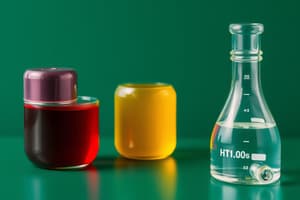Podcast
Questions and Answers
Which statement accurately distinguishes between metals and non-metals?
Which statement accurately distinguishes between metals and non-metals?
Which element is most likely to exhibit high reactivity with water?
Which element is most likely to exhibit high reactivity with water?
What is the primary characteristic that defines elements within the same group on the periodic table?
What is the primary characteristic that defines elements within the same group on the periodic table?
What distinguishes a cation from an anion?
What distinguishes a cation from an anion?
Signup and view all the answers
In standard atomic notation, what does 'Z' represent?
In standard atomic notation, what does 'Z' represent?
Signup and view all the answers
Which of the following accurately represents the distribution of electrons in the third energy level (shell) according to the 2n² rule?
Which of the following accurately represents the distribution of electrons in the third energy level (shell) according to the 2n² rule?
Signup and view all the answers
How does an ionic compound typically form?
How does an ionic compound typically form?
Signup and view all the answers
How would the number of valence electrons in an atom of oxygen (which belongs to Group 16 of the periodic table) compare to an atom of Sodium (which belongs to group 1)
How would the number of valence electrons in an atom of oxygen (which belongs to Group 16 of the periodic table) compare to an atom of Sodium (which belongs to group 1)
Signup and view all the answers
Which of these statements is true of metalloids?
Which of these statements is true of metalloids?
Signup and view all the answers
When an atom of chlorine (Cl) gains one electron, what type of ion is formed?
When an atom of chlorine (Cl) gains one electron, what type of ion is formed?
Signup and view all the answers
Study Notes
Organization of the Periodic Table
- Elements are categorized as metals, nonmetals, or metalloids.
- Metals conduct heat and electricity, are malleable and ductile, and have high melting points. Examples include iron and copper.
- Nonmetals are poor conductors of heat and electricity, are brittle, and have low melting points. Examples include oxygen and nitrogen.
- Metalloids have properties of both metals and nonmetals. Examples include silicon and boron.
Chemical Families
- Alkali metals (Group 1) are highly reactive, especially with water. They are soft and shiny.
- Alkaline earth metals (Group 2) are less reactive than alkali metals, are harder, and have higher melting points.
- Halogens (Group 17) are very reactive and form salts with metals. Examples include chlorine and fluorine.
- Noble gases (Group 18) are inert, stable, and non-reactive. Examples include helium and neon.
Periods and Groups
- Periods are horizontal rows on the periodic table. Elements in the same period have the same number of electron shells.
- Groups are vertical columns on the periodic table. Elements in the same group have similar chemical properties due to the same number of valence electrons.
Valence Electrons
- Valence electrons are the outermost electrons in an atom, and are involved in bonding.
- The number of valence electrons determines an element's chemical reactivity.
Atoms and Ions
- An atom is a neutral particle made up of protons, neutrons, and electrons.
- An ion is a charged particle formed when an atom loses or gains electrons. Positive ions are called cations, and negative ions are called anions.
Standard Atomic Notation
- Atomic number (Z) is the number of protons in an atom, and determines the element.
- Atomic mass (A) is the average mass of the element's isotopes.
- Protons have a positive charge and are found in the nucleus.
Bohr-Rutherford Diagram
- A diagram showing electrons in energy levels around the nucleus.
- The number of electrons in each shell follows the 2n² rule.
Ionic and Covalent Compounds
- Ionic compounds are formed when atoms transfer electrons to achieve a full outer shell. These are typically formed between metals and nonmetals.
- Examples include sodium chloride (NaCl).
- Covalent compounds are formed when atoms share electrons. They typically occur between nonmetals.
- Examples include water (H₂O).
Naming and Formula Writing
- Ionic compounds are named by first naming the metal, then the nonmetal with the suffix "-ide." Example: NaCl is sodium chloride.
- Covalent compounds use prefixes to indicate the number of atoms. Examples include carbon dioxide (CO₂).
Density Calculations
- Density is calculated as mass divided by volume (Density = Mass/Volume).
- Units for density are g/cm³ or kg/m³.
- Formulas for calculating mass or volume: Mass = Density × Volume and Volume = Mass/Density.
Studying That Suits You
Use AI to generate personalized quizzes and flashcards to suit your learning preferences.
Related Documents
Description
This quiz covers the organization of the periodic table, focusing on the classification of elements as metals, nonmetals, and metalloids. It also explores chemical families such as alkali metals, alkaline earth metals, halogens, and noble gases. Test your knowledge on periods and groups in the periodic table.



